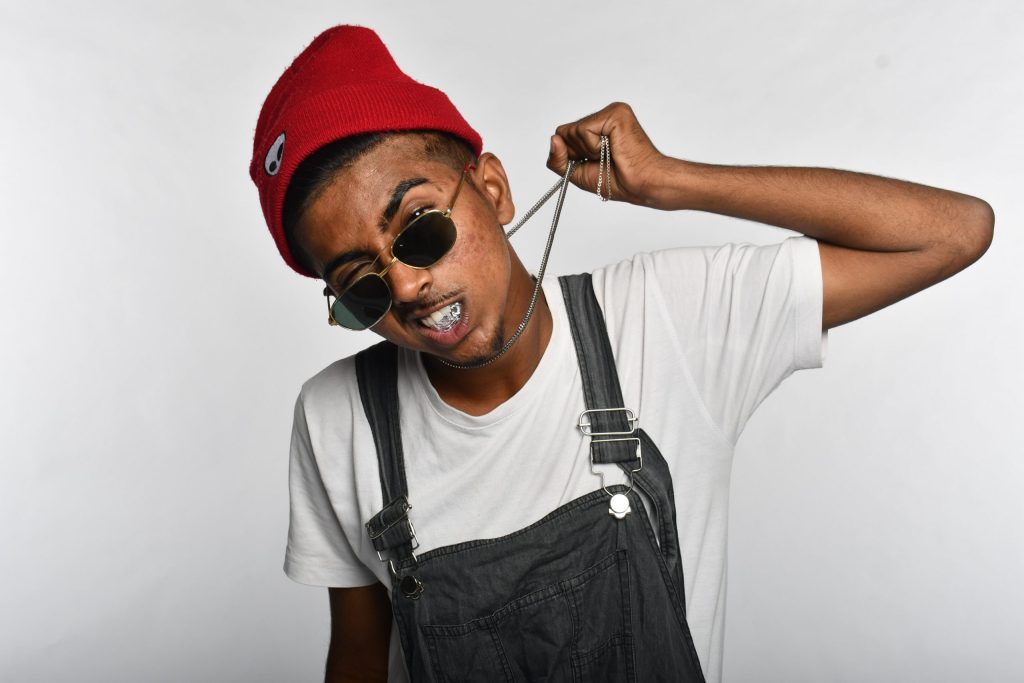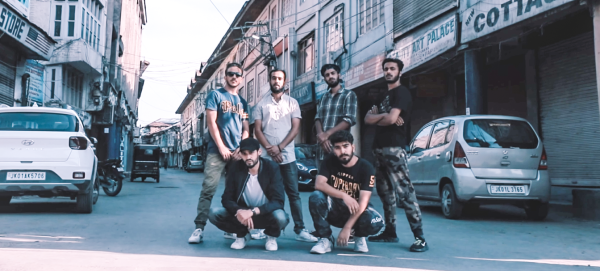Community drivenReviewsInterviewsFeaturesPodcastsStoriesProfilesWe are offthedome.
Consider this, within the conventions of the Indian Society, within the compact walls of values and cultures with only so much space to move and try to be different, within the judgemental few who always consider you vague should you choose to break the norms, living within the constant pressure of poverty pushing you further from the gates of artistic freedom, spending your childhood in an area that is filled with criminals and delinquents and living within a lack of choice to associate yourself with the better ones and have a normal life, would you even think of choosing something that is just so new and raw in India? Doing something that has a lot of uncertainty as far as success is concerned? No, right?
Well, the case of Altaf Shiekh is quite different. The viral sensation and one of the most talked about personalities since last year, MC Stan is a 24-year-old rapper-producer, also known as the winner of Bigg-Boss S16, but, of course, we wouldn’t dive in with that achievement in mind – this isn’t your casual TV-talk blog. Rapping since his childhood, thanks to his elder brother, he has had a keen interest in the culture of Hip-Hop since a very young age. Being in 6th STD, a kid from one of the most backward areas of Pune – Tadiwala Road, found something that he could find relatable in a lot of aspects. Tadiwala Road is a place where crimes such as murder, attempted murder, stabbing and beating, robbery, dacoity, and a lot more are done by local criminal gangs and delinquents daily. A place where distinguishing between right and wrong, as a young kid, is very difficult as you adapt to the environment because of peer pressure and to feel ‘included’.
Having lived in an environment wherein the rather younger males were full of anger, pride, jealousy, and resentment, Stan didn’t have an option but to settle in. One shouldn’t defend the things he has done as an individual, the immature choices he has made causing danger to people, but one should also understand where this has stemmed from. There is no doubt in the fact that he had a lot of trauma as a child, from witnessing an attempt to murder a friend who was enjoying his birthday party to robberies and gang crimes daily, he didn’t really have the liberty to sit back and consider ethics and morales as these crimes were too normal and casual in his area. Stan has had his own share of illicit activities that he has been bashed for as well, so there isn’t something new to talk about in those aspects. However, the after-effect those experiences had on him is a different story altogether.

Remember how core Hip-Hop was usually considered closely associated with gang crimes and criminal life? How did the rappers of California, especially Compton, literally start gangster rap (Eazy-E is also named the godfather of Gangsta Hip-Hop) and talk about the atrocities they’ve seen being committed? The way Kendrick Lamar, a conscious poet, talked about how messed up his life was in ‘Good Kid Maad City’? This was something Altaf found relatable (so much that he would later grow up and get Compton tattooed on his chest), he saw the crimes being talked about, the environment in the ‘trenches’ and the effect of your hood, the place you belonged to, in your life. Being a big fan of Tupac, the 13-year-old would visit cyber cafes, watch as many music videos, and listen to as many tracks as he could. He was heavily influenced by the personality of these rappers and the way they conveyed what they saw and did through music. Soon after, he tried his hands on a cracked version of FL Studio on a barely working laptop that his brother gave him. Younger Altaf was so dedicated to getting to know more about Hip-Hop that he went ahead and joined an English Class to better understand what was being talked about. This influence gave birth to MC Stan as we know him, the Hip-Hop tracks, the makeshift laptop, and the cyber cafes were enough to allow him to dream bigger.
Soon after, a young and savage MC Stan started to get into making his own tracks. He talked about his life, got into the generic flex game, and tried different flows and rhyme schemes. His earliest track on YouTube is rumoured to be ‘Mera Flow’, a rather mediocre track on an old-school beat with hardly any mixing and quality production, but hey! What should you expect from a self-taught 17-year-old trying out music without any experienced teacher or mentor? There weren’t many people in his network that he could ask to produce for him since Hip-hop as a genre itself was very new and people either weren’t aware of DAWs or just didn’t know how to use them. Anyways, Stan kept on working on himself, introspecting and learning better production. His next notable work was when collaborated with ‘MC THC’ on “Trippin”. The beat was quite old-school but improved, with better drums and instruments, better flows, and bars, One could say it was acceptable within industry standards (if there are any in DHH).
What happened later was very unexpected, something that would change the whole setting of the Hip-Hop community as we knew it that time around. In the track ‘Samajh Meri Baat Ko’, Stan openly called out Divine and Emiway Bantai and started the diss culture through tracks by calling out the mainstream faces of Hip-Hop. Of course, there were diss battles and subliminals in songs, but what Stan did wasn’t ever done before in India. This led to a chain reaction, a diss season in Hip-Hop, Emiway dissed Raftaar and Divine in the same track he replied to Stan in, Raftaar and Divine replied and the whole thing went back and forth. Stan was apparently in jail at the time Emiway dropped his diss, and he wrote his reply whilst being behind bars. As soon as he got bailed out, the 18-year-old replied with a five-minute track and spoke his heart out.
This is the point where Stan gained negative popularity, people would watch him just to hate on him, type in abuses and call him all sorts of slurs. This didn’t affect him, he could have continued to milk the situation as much as he could, make another diss for the sake of it, but he chose not to. This was also the time when he was offered labels and deals with enough money to fulfil his needs, if any. For any other guy who rose from the slums and lived in poverty, the decision to get signed shouldn’t be hard, but he declined every offer. The choice to be independent was simple, retaining his originality and ingenuity was what mattered to him the most, which is something more than money could buy. He later partnered with Nofiltr Creative and made better-quality music videos.
Getting hate was very usual for him at this point, almost every track got a huge number of dislikes and hateful comments. ‘Astagfirullah’, however, was a game changer for him. At the age of 20, he made a track wherein he vented his heart out, showed his vulnerable side, and talked about the difficulties he faced. This track was so heartfelt that it changed the minds of all of his haters, this again, was never done before in DHH. While the whole scene was saturated with flex tracks, raps made on partying, girls, love, money, and other different things, Stan made an emotional one where he contrasted an ideal life with the one he was living. Seeing rappers getting emotional and sentimental was something very new in Hip-Hop and that too by a youngster with a story to tell. He answered back to the privileged and inconsiderate ones who hated his style, his way of speaking, and essentially his overall persona. He talked about how life in the backward classes of society is very difficult.
Soon after, Stan began working on what’s arguably termed the Best Album in DHH, “Tadipaar”. An album that straight-up defied any and every norm in Hip-Hop. An album that was to stay relevant for years to come. A game changer, in the sense that the influence ‘the sound of Tadipaar’ had was very evident in the whole community. Tadipaar, a collection of six tracks, an interlude and an outro, was crafted so meticulously, that it made it hard for the critics to believe that all of it was done by one single person, a bedroom producer and a Mic Controller. The story was about how Stan got exiled from his city, the events that led to it, and the aftereffects it had on him as an artist as well as a person. Tadipaar also foreshadowed certain things such as the flaws in our legal system, police brutality, religious beliefs, trust issues, and a lot more. The album is layered precisely in both the story and the sound. The sound of Tadipaar is a case study in itself, the quirky samples, the ad-libs and the placement of additional vocals, perfect drums and percussions, build-ups and beat drops, beat switches (the title track ‘Tadipaar’ itself has 7 beat switches) and flows, different rhyme schemes, playing with time signatures, voice effects, you name it. Tadipaar was simply quintessential, it paved the way for a new sound in Hip-Hop, influenced a large number of people, and showed how originality and inventiveness can make you reach new levels. Although a very popular project,’ MC Stan Type Beat (Outro)’, was one particular piece that might not have been appreciated enough. The ten-minute beat was a statement in itself, it boasted about the production capabilities Stan had, and naming it Stan Type Beat was a witty way of implying that Stan is the only one capable of making a type beat of himself. This goes without saying that the music videos of Tadipaar were quite essential in the success of the album. The tracks would go trending at the time of release, and with each track, Stan would be changing the soundscape of Hip-Hop one by one, introducing a new freshness in the saturated scene with particular genres, and making a lot of the mainstream rappers insecure in the process.
Now, if Tadipaar was this successful, it only made sense to stick to the formula right? An original recipe for making hits because obviously, the whole scene was enjoying it, openly or secretly. But this wasn’t an option for Stan. Just after celebrating the album’s success, he parted ways with Nofiltr and began working on a new sound. Some might call it mumble, others term it as ‘western influence’, but the reality is that with ‘Snake’ Stan introduced New School Trap and Melodic Rap in his way. A whole different sound that irked a huge chunk of his audience in the initial listens, This was when he was again losing some of his audience, people were not very appreciative of the heavily autotuned vocals and melodies, but that didn’t affect him. The sheer strive to be yourself and care less about the noise against your ingenuity is something Stan’s artistry boasts about. Daring to switch sounds again and again, just so the soundscape of the scene is fresh and new is one of the many things admirable about the prodigy.
Soon after, his sophomore album ‘Insaan’ would roll out. The whole setting was based on Stan being introspective and preaching his philosophies, he talked about emotions, relations, the importance of one’s parents, and tons of other things. This was also the first time he featured mainstream/commercial rappers namely Ikka and Raftaar on his project. The whole sound was very new in India, and although inspired by the West, he did add his own elements to make it original and fresh for a layman’s audience. The traplike soundscape had a major influence on a lot of up-and-coming artists who took it up and carried it forward. However, Stan would again switch genres and get into a more bouncy zone with his recent tracks like ‘Shana Bann’ and ‘Nusta Paisa’.
One can’t stress enough how Stan is an exemplar of how experimental and original an artist can be. Being a part of an industry where artists are either signed to a label getting their hands tied and keeping on feeding their audiences with what they like, to other independent rappers who keep on working on one ‘hit making’ formula, Stan retaining his originality and being very different from the whole sound of India is simply estimable. His style boasts about how he literally lives Hip-Hop instead of being like the others practising it. His whole lifestyle is based on the culture, the way he speaks, the way he styles his hair(dreadlocks), his attire and fashion sense(bandanna), his renowned jewellery, his blunt and blatant self that he features on his tracks showcases his dedication to the culture of Hip-Hop.
Being a man of few words in his In-Real-Life persona, Stan often feels pride over representing his city through his music. Despite being exiled from Pune in 2018 and living in Mumbai ever since, he never misses an opportunity to give a shout-out to the city he owes everything to, ‘P-Town’. Stan shed a lot of light on the growing Pune Hip-Hop scene too, while a lot of the rappers were copying him, there were a few original ones who deserved to be known. The influence Stan’s success has in his own city can be explained by the cafes, gyms, boxing clubs, and bars renaming themselves to ‘P-Town’ taking pride in the city’s very own prodigy and emissary of originality, experimentalism, and realism – MC Stan.





